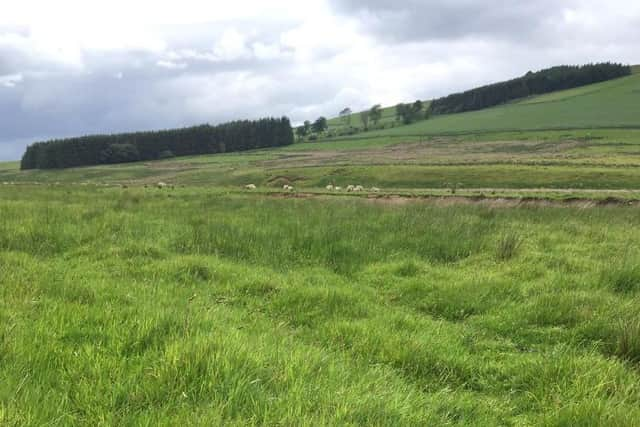Farming holds the key to survival of Curlew
and live on Freeview channel 276
The only places you will hear it now in Northern Ireland in the spring and summer months are around Lough Erne in Enniskillen or on the windswept uplands of Glenwherry in Antrim. Reduced from a few thousand breeding pairs spread right across the farmed landscape in the 1980s to just a couple of hundred today in two locations, it is following the tragic trajectory of the Corncrake.
The Eurasian Curlew is Europe’s largest wading bird, it has a body the size of a duck with long legs, long neck, and small head, which sports a beautiful, long, downward-curving bill. The female’s bill is longer than the male’s, around 15 cm. Its colouration is grey, brown, and cream, with a subtle yet intricate patterning that merges well with mud, water and the muted colours of fields and moors.
Advertisement
Advertisement
Curlews are shy, even illusive, and getting close to them is difficult, they take flight in alarm at any disturbance, calling their name – curlee, curlee - a sharp arrow of a cry that fires across the land.


This is the sound most people hear in the winter around the coasts, where large numbers can gather to sit out the colder months, and Irish birds are joined by Curlews from continental Europe.
This call, though, is not what has endeared them to Irish hearts for generations, what has cleaved them to us is the sound that once defined springtime in the fields.
Come the breeding season Curlews leave the coasts and move inland.
Advertisement
Advertisement
As they pair up and define their territories, they soar on fresh April winds trilling and bubbling in a crescendo of bitter-sweet notes.


Yeats was so captivated by the bubbling call of the Curlew he wrote, “The three oldest cries in the world are the wind cry, the water cry and the curlew cry.” This is what has inspired countless generations, but now it is falling silent.
Curlews everywhere are collateral damage to modern ways of farming, especially the frequent cutting of grass for silage, which can begin as early as late April in some areas.
As the birds lay their clutch of 3 or 4 eggs in a nest which is little more than a scrape on the ground, they are vulnerable to harrowing, rolling and silage production.
Advertisement
Advertisement
Machines are fast and efficient today, far more so than in the past when farmers may have spotted a nest before going over it. High off the ground, enclosed and travelling at speed, an operator has little chance of hearing or seeing a bird calling in alarm, let alone a nest in the grass.
The transition from wildflower meadows to fast-growing rye grass has been disastrous for ground-nesting birds. Colourful, varied, insect-rich fields with different sward heights have become uniform monocultures, making it hard for the birds to hide their nest and for the chicks to travel through and find food.
The grass grows quickly, becoming too dense and too long for chicks, and they easily chill in wet weather.
The use of pesticides has meant food is also more scarce. In addition, modern life has made it easy for generalist predators like foxes and crows, which proliferated in the twentieth century.
Advertisement
Advertisement
Without large predators such as eagles and wolves to keep their numbers in check, and with so much food available in the town, cities and the countryside, they have burgeoned in number.
These intelligent predators easily find nests and young chicks. If the machines don’t get Curlews, they succumb to mammalian and avian hunters.
Other pressures come in the form of development on breeding grounds, climate change creating drought or floods, forestry plantations which swallow up suitable habitat and house more predators, and disturbance from dog walking and leisure activities.
These additional issues make it death by a thousand cuts for Curlews and other birds that nest on the ground in our busy, efficient landscapes.
Advertisement
Advertisement
Is it inevitable that Curlews will disappear from Northern Ireland? They are not an economic bird, no one makes money from them, there is no practical reason to welcome them. I don’t believe that is what people want. There are ways to grow food and support the wildlife that brings so much our lives.
The work of the RSPB in Northern Ireland has shown that by putting electric fencing around nests and carrying out predator control, Curlews can produce enough chicks to sustain a population, and even grow in number - they could, given a chance, once more populate the fields of Northern Ireland.
Curlews only need to fledge one chick a year to grow numbers and expand, in time, they will re-colonise their former range.
With concerted effort, the right agri-environment schemes and the will of farmers and the support of the community, that can be achieved; extinction isn’t inevitable.
Advertisement
Advertisement
If they do recover and the nests can be found and fenced off to protect them from mammals, if alternative cutting regimes help chicks escape the mower, or if agri-payments can compensate for not cutting or at least delaying harvesting to late in the summer, and if predator pressure can be reduced in the breeding season, Northern Ireland’s beautiful landscapes could, once again resound to the bubble of the Curlew.
Farming holds the key to the survival of the Curlew. Farmers are the custodians of the land’s productivity and its heritage.
To pass on to the next generation a productive farm that sings to the call of the Curlew has to be a positive goal.
Providing healthy food and protecting a bird that has been so much a part of Irish history and culture is eminently possible.
There is no other birdsong that has quite the same effect on us as the call of the Curlew, it goes above and beyond; to let it slip away now would be a tragedy.